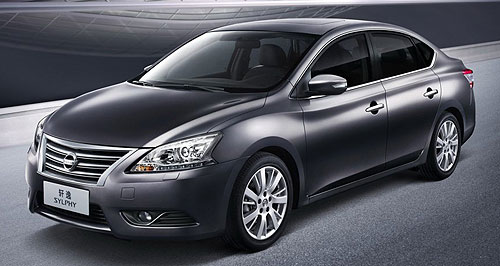Make / Model Search
News - General NewsHandbrake turn for Chinese car marketEnd of an era: The Nissan Sylphy (aka Pulsar sedan) has been the top-selling passenger car in China recently, but such vehicles are set for a showroom struggle as the economic situation in the world’s biggest motor market develops cracks. June vehicle sales down 3.2 per cent in China as buyers brace for economic turmoil9 Jul 2015 CHINA’S new-vehicle market that once enjoyed breakneck average sales growth of more than 24 per cent a year over a decade has suddenly stepped into quicksand, with June car sales going into reverse on the back of adverse economic news. The China Passenger Car Association reported a 3.2 per cent drop in sales last month compared with June last year, down to 1.43 million units, pushing the Chinese industry – the biggest in the world – into unchartered waters. While that decline does not look so dramatic compared with the 30 per cent rout of the Shanghai stock market, independent Chinese news reports suggest the major car-makers have been slashing retail prices to keep stock moving, while all the time eyeing burgeoning stockpiles of unsold vehicles. The worrying signs in the Chinese economy suggest worse might be to come, with the motor industry’s 2015 sales forecast of 25 million units – a year-on-year gain of 7.0 per cent over last year’s 23.5 million – looking decidedly optimistic as potential buyers keep their wallets firmly in their pockets. Ford and its Chinese joint-venture partner Changan reported a sales fall of 3.0 per cent in June, while General Motors and partner SAIC eked out a gain of 0.2 per cent, helped by savage discounts. Running contrary to the trend was Mercedes-Benz, with 38 per cent sales growth in June compared with the same month last year. According to China Association of Automobile Manufacturers (CAAM) figures, the cracks started appearing in April when sales flattened out after an impressive March. In May, sales slipped compared with the previous year. Manufacturers, whose previous main problem had been where to build new factories to ramp up production, suddenly were forced to wind back output – a situation that deepened in June. Worse for the manufacturers, exports of Chinese-made vehicles have fallen 7.3 per cent this year. The precarious situation raises the question of whether the Chinese industry is sustainable in the current form, with no fewer than 100 brands – 29 foreign and 71 Chinese – trying to find a foothold. The market is dominated by the big joint ventures between western partners such as GM, Volkswagen, Ford, Nissan, Toyota and Hyundai with Chinese companies such as SAIC, FAW, Changan, Dongfeng and BAIC, but for every one of those, there are several other tiny manufacturers attempting to make a go of it, often with the support of far flung provincial governments. Compounding the problem for the car-makers is a cap on vehicle sales in big cities such as Beijing and the rise of the second-hand vehicle market – a relatively new phenomenon in China where the growth of private car sales only really hit its straps about 15 years ago. From 2001 to 2010, the average annual sales growth for passenger vehicles was 24.1 per cent, with the market first overtaking Japan, then Europe and the United States to become the biggest on the planet. While that helter-skelter expansion has slowed to about 6.8 per cent in recent years, the numbers of new vehicles pouring on to Chinese roads has still been massive. Many of those are now back in the used car lots, giving buyers an alternative to new models. For Australia, the end of unfettered domestic car sales growth in China might signal an uptick in Chinese activity here, as manufacturers look anew at exports to soak up unused manufacturing capacity. To date, the manufacturers have had trouble just filling the order books at home, but that no longer seems a viable business model. Some Chinese manufacturers such as Great Wall Motors have seen this situation looming, and as GoAuto has reported, the company is committed to developing export versions of its Haval SUV range – China’s most successful – in both right- and left-hand drive, and to western standards of design, quality and safety, from the outset. The big change will come when one of the major western brands such as GM or VW decides to add Chinese-made vehicles to their export roster – something they have been reluctant to do to date due to concerns about quality, both real and perceived.  Read more |
Click to shareGeneral News articlesResearch General News Motor industry news |











Facebook Twitter Instagram